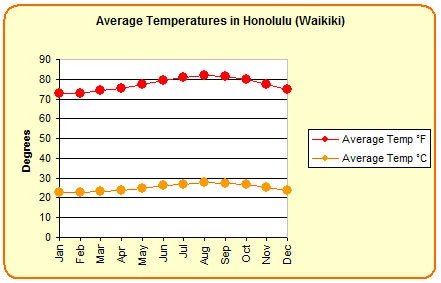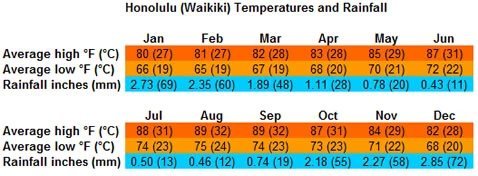Oahu Weather
Oahu's weather is generally warm and sunny year-round, with the south and west shores being drier than the lush, rainier east side. Thanks to prevailing northeast trade winds, Waikiki and Honolulu enjoy mostly pleasant conditions, with brief showers and average ocean temperatures ranging from 75°F to 80°F throughout the year.
Just like on the other main Hawaiian islands, the weather on Oahu's south and west shore is usually drier and sunnier than on the island's east shore. That's because the predominant tradewinds are blowing from the northeast about 90% of the time and these winds bring moisture with them. As these moisture-laden clouds approach the islands, they get stuck on the mountains, where the moisture comes down as rain. The weather on Oahu's windward (east) shore is therefore usually a lot wetter than on the leeward (west) shore. But thanks to the rain, the windward coast is green and lush while the leeward coast is dry and has no rainforests.
Waikiki, a Honolulu neighborhood, is where most visitors to Oahu are headed since this is where most of the accommodation options (hotels and resorts) are located. Waikiki is on Oahu's sunny south shore. It is sheltered from most rain clouds by the Ko'olau Mountain Range. These mountains are visible from Waikiki. On most days of the year one can see grey or dark clouds hanging over the tops of the mountains. But not to worry, the clouds usually stay right there and with them the rain. And when it does rain on Oahu's south shore, it is usually short-lived. Here is an overview of Honolulu's year-round temperatures.
Oahu's average ocean temperature is around 75°F (24°C) in February and 80°F (27°C) in September.


Volcanic smog (vog) on Oahu
Vog (volcanic smog) is much more common on Hawaii's Big Island than on Oahu since the Big Island is the only Hawaiian island that still has active volcanoes. Occasionally when the winds are blowing from the south (known as Kona winds), the vog from the Big Island's volcanoes affects the air quality of the other Hawaiian islands, including Oahu.
On those days you will notice a haze in the air, especially when looking into the distance. While most people can tolerate vog and won't notice any difference in how they are feeling, for those with asthma or other breathing problems vog is much more of an issue and it is best be avoided by staying indoors.
Frequently Asked Questions about Oahu Weather
Which part of Oahu has the best weather?
The south and west shores, including Waikiki and Ko Olina, are the sunniest and driest areas on the island.
Does it rain a lot in Oahu?
Rain is common on the east (windward) side due to trade winds, but much less frequent on the south and west coasts.
What is the average temperature in Honolulu?
Daytime highs average between 80°F and 89°F year-round. Evenings are comfortably cooler.
How warm is the ocean around Oahu?
Oahu's ocean temperatures average 75°F in winter and 80°F in summer, making it great for year-round swimming.
What is vog and does it affect Oahu?
Vog (volcanic smog) from the Big Island may occasionally reach Oahu when winds shift, affecting air clarity and breathing for sensitive individuals.








